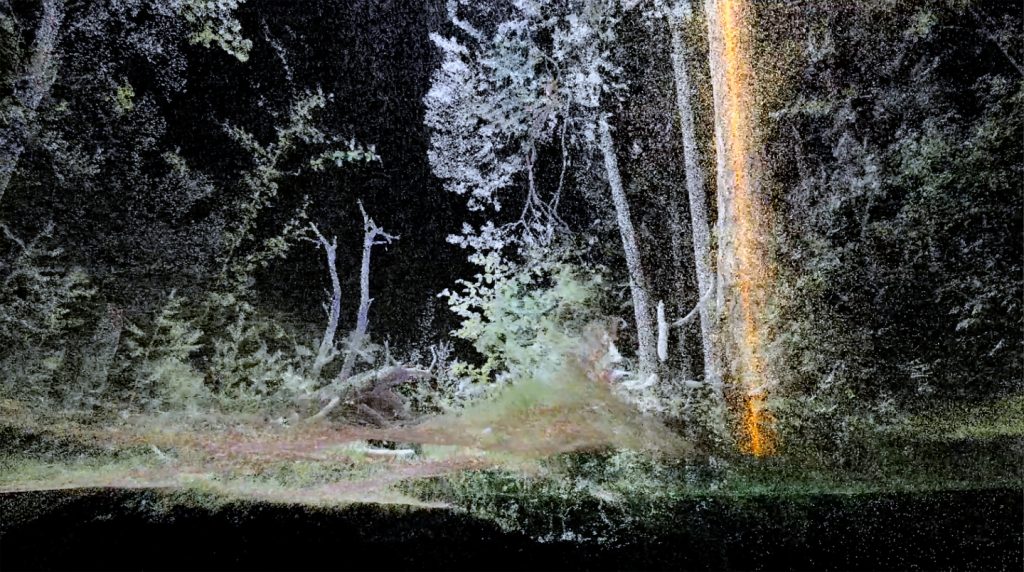
After Chernobyl’s radioactive danger zone in ELS #3, we are now heading for other critical zones – worldwide on the one hand, and locally in the Pfyn Forest on the other, which we investigated in the Acoustic Ecology online course this semester.
With “Critical Zones” the French sociologist and philosopher Bruno Latour describes the thin layer of the earth in which life takes place, or is possible at all: It is the few kilometres thick biosphere that extends from the pedosphere into the atmosphere. This biosphere has been brought to a critical state by man in many places – environmental pollution, climate change, resource depletion; the diverse and pressing environmental problems are well known.
In the exhibition “Critical Zones. Observatories for earthly politics”, which Bruno Latour curated with Peter Weibel, Bettina Korintenberg and Martin Guinard for the Center for Art and Media in Karlsruhe, artistic strategies are presented that deal with life on a damaged planet. Not only the survival and coexistence of all forms of life on earth is the topic of the exhibition, but also how we can perceive and respect the natural environment in new and different ways: Through artistic-scientific observation systems that aim to give non-human living beings a form of expression – a voice – that is understandable to us, thus changing our anthropocentric worldview to an eco-centric, terrestrial view, where we realize that all life forms on Earth are mutually dependent – or as Donna Haraway says: “There is no becoming, there is only becoming-with.”
The Pfyn forest in Valais is already severely exposed to effects of climate change. Due to the mass elevation effect of the Alps, the climatic conditions in the Valais are already very dry. The ever-longer periods of drought and heat are severely damaging the forest: the Scots pines, which make up a large part of the Pfynwald forest, are dying and are being displaced by more robust tree species, including neophytes. It is a climate-induced vegetation change in progress, the progression of which makes it unclear whether the Pfynwald will change from pine to oak and robinia forest in the coming decades or the perimeter will turn into a steppe landscape and the forest in the heart of the Pfyn Nature Park will disappear completely.
Two contributions from the Pfynwald are also on view in the exhibition. It is Rasa Smite and Raitis Smits’ 3D animation “Atmospheric Forest” and Marcus Maeder’s installation “Perimeter Pfynwald”. Both contributions were developed within the framework of the research project “Ecodata-Ecomedia-Ecoaesthtics” of the FHNW Basel under the direction of Yvonne Volkart and were supported by the Swiss National Science Foundation. Since the exhibition can only be seen online for the time being due to the Corona crisis, the artists have developed interactive online versions of their installation. However, participants of this ELS are strongly recommended to visit the entire virtual exhibition. It is available here:
Please click on the blue titles for getting to the works directly:

“Atmospheric Forest visualizes the complex relations between a forest, climate change, and the atmosphere. It is the result of a three-year artistic research project on Pfynwald, an ancient Alpine coniferous forest suffering from drought, which Swiss scientists have turned into a living observatory.
Trees are not only oxygen generators, but they breathe as well, emitting large amounts of volatile organic compounds – a habitual scent of the forest. Scientists have long known about the link between a fragrant forest and the warming climate, but are uncertain about its impact and scale of these compounds. By visualizing the data of volatile emissions and resin pressure in pine trees during one growing season, Atmospheric Forest reveals patterns of this complexity, showing that with climate change we are heading toward a more fragrant and more “atmospheric forest” in the future.”
© Rasa Smite, Raitis Smits
Produced in collaboration with the Ecodata Project Basel, the ZKM | Karlsruhe and RIXC, Riga.Research: Rasa Smite in the framework of Ecodata–Ecomedia–Ecoaesthetics (2017–2020) research project led by Yvonne Volkart, hosted by The Institute of Aesthetic Practice and Theory, HGK FHNW (Basel, Switzerland)
Research support: Swiss National Science Foundation
Scientific partners and data: WSL – Swiss Federal Institute for Forest, Snow and Landscape
Research scientific advisers and data: Andreas Rigling, Arthur Gessler, Christian Ginzler, Mauro Marty (WSL, Switzerland), Kaisa Rissanen (Helsinki University, Finland and visiting researcher at WSL, Switzerland), Michel Kalbermatter (VP Swiss Teleport, Signalhorn AG (Leuk-Stadt, Switzerland)
Project partner: RIXC (Riga, Latvia)
VR programming: Kristaps Biters (RIXC)
2. Marcus Maeder: Perimeter Pfynwald, 2020

The installation is an acoustic-artistic representation of the Pfynwald in Switzerland, a forest which is already affected by climate change. In 2018, Marcus Maeder captured sounds of the Pfynwald forest by placing four recorders in different biotopes several kilometers apart. The Pfynwald ecosystem can now be experienced in a way that would not be possible outdoors – through spatial and temporal compression (e.g., acoustic time-lapse and spatial arrangement). Thus, it is possible to experience how drought and heat affect the forest’s soundscapes between spring and fall: the fauna changes or retreats, mountain streams dry up, while the main river becomes louder with increasing melt water of glaciers. The humidity decreases and the temperature rises – microclimatic measurements are used to generate a synthetic forest voice. As air humidity decreases, the sonification gets lower in pitch; and with increasing temperatures, the sonification gets higher – until both lie outside of the audible range and the forest’s voice is silenced.
Produced in the framework of the Ecodata–Ecomedia–Ecoaesthetics (2017–2020) research project led by Yvonne Volkart, hosted by The Institute of Aesthetic Practice and Theory, HGK FHNW (Basel, Switzerland).
Research support: Swiss National Science Foundation. Comissioned by ZKM, 2020.
Scientific partners and data: WSL – Swiss Federal Institute for Forest, Snow and Landscape. Programming: Ken Gubler.
A bachelor thesis at the ETH Zurich was also written about the soundscape of the Pfynwald :”Exploring acoustic dynamics at Pfynwald: The soundscape of a xeric forest ecosystem” by Martin Rüegg: